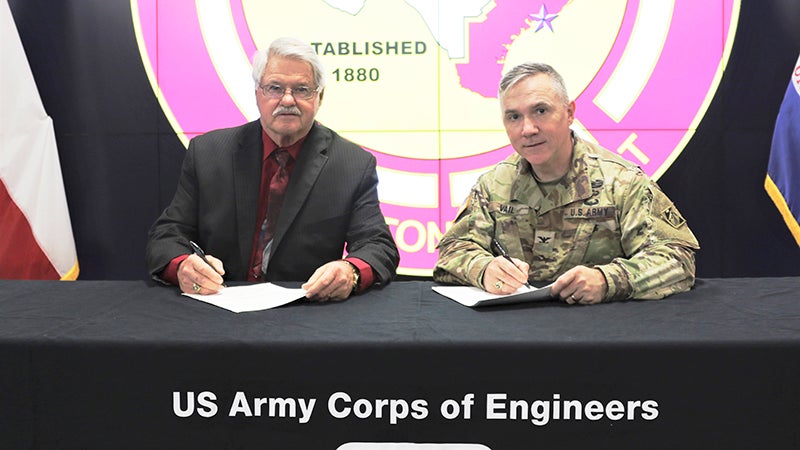Check out details of hurricane levee work slated to start this year
Published 12:13 am Tuesday, January 28, 2020

- Jefferson County Drainage District No. 7 Board of Commissioners President Richard Beaumont, left, and Col. Timothy R. Vail, commander of the Galveston District U.S. Army Corps of engineers, sign a Project Partnership Agreement that includes hurricane levee improvements. (Courtesy photo)
The three-element Sabine Pass to Galveston project will begin with construction of the Port Arthur section this year.
To date, Jefferson County Drainage District No. 7 is the only one of the three that has entered into a Project Partnership Agreement with the Galveston District Corps of Engineers. The other two project elements will include improvements to the Freeport area levee system and a new levee system for Orange County.
“The Galveston District would like to recognize the Jefferson County Drainage District No. 7 for outstanding work and partnership in the effort to fund and construct this monumental project,” said Col. Timothy R. Vail, commander of the Galveston District U.S. Army Corps of engineers.
Phil Kelley, manager of DD7, said the Port Arthur element includes improvements to the existing hurricane levee system.
The Corps performed a feasibility study that was completed prior to Hurricane Harvey using a projected sea level rise 50 years out as well as taking into account increases in storm surge impact.
Kelley said Harvey overshadowed 2008’s Hurricane Ike but these were vastly different systems. Harvey dumped monumental amounts of rain while Ike came in with a storm surge of about 14 feet. Without the levee system, the surge would have moved farther inland to possibly the Mid-County area.
The project, he said, is beneficial to the area.
“It will reduce the risk and build in more resilience to the current system to withstand some of the more stronger storms, storm surge wise,” Kelley said.
The project calls for some areas of the levee to be raised 2 to 4 feet.
The first area to see improvements is around Valero Refinery’s Sabine tank farm off Texas 87. A breach in the levee system on Texas 87 before the Intracoastal Canal Bridge saw an intermediate fix by DD7 that will eventually be rebuilt and raised.
Other sections that currently have the steel sheet pile I-shaped wall will be converted to an inverted concrete T-wall. Kelley said the steel sheet pile I-wall is no longer an acceptable Corps of Engineers design and that decision came about after Hurricane Katrina, when the surge ran over the I-wall and caused the I-wall to fail.
There will also be revisions to a section of the levee that runs though the Port of Port Arthur and behind Port Arthur City Hall, whereas the steel wall will be converted to a concrete T-wall.
Funding
The funding is somewhat complicated.
The USACE Galveston District received full funding for the new start construction of the Sabine Pass to Galveston Bay project as part of the Bipartisan Budget Act of 2018 appropriated by the United States Congress in November 2018, according to information from the USACE.
In 2018, the Southwestern Division established the $5.2 billion program, funded by the 2018 Bipartisan Budget Act, to reduce the risk of flooding impacts from severe storms.
Kelley said $3.9 billion is dedicated to the state of Texas for the Sabine Pass to Galveston Bay project and the estimated cost to do the Port Arthur section is over $800 million.
“And DD7, as the local sponsor of the project, is responsible for 35 percent cost share,” he said. “That means the DD7 portion is a little over $300 million.”
But DD7 doesn’t have that much money at its disposal so officials are working with the governor’s office, Texas General Land Office and members of the state legislature to get the money appropriated from the state for the project.
This project could eventually tie in with the separate Coastal Spine, or Ike Dike. State Sen. Larry Taylor, R-Friendswood, was instrumental in sponsoring legislation in the last session to fund $200M to the Sabine to Galveston Bay project.
The Coastal Spine Project is on the back burner while waiting for funding. In the meantime, Taylor has sponsored a bill that could help with the cost sharing where money would go to the GLO to serve as part of the cost sharing 35 percent.
The current levee system consists of 27.8 miles of earthen embankment and 6.6 miles of floodwall.


